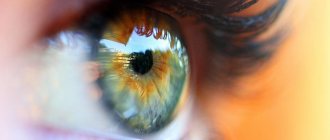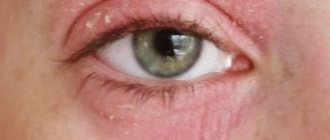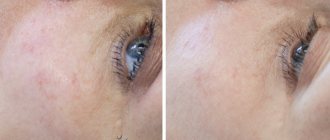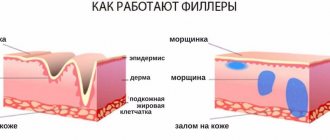A problem that always worries parents is the appearance of swelling on a child’s face. This excitement is to some extent justified. Bags under a child's eyes form for various reasons: from an unbalanced diet to serious pathologies. Therefore, before dealing with a cosmetic defect, you should find out from your pediatrician the reasons for its occurrence.
Why does my child have bags under his eyes?
Eyes are one of the most vulnerable parts of the human body. In order to reduce the risk of injury, nature has provided a protective system around the eyes in the form of a kind of shock absorber. Its role is played by periorbital tissue - adipose tissue that minimizes the risk of injury and drying of the eye.
Under the influence of negative factors, fiber “grows” and accumulates water. The adipose tissue stretches the thin connective membrane and “extends” beyond the orbit, which is why bags form under the eyes even in infants.
Such eye swelling is not painful (unless it is caused by inflammation), but it makes parents nervous. Until it is clarified why the child has bags under the eyes, you should not engage in independent treatment; you should consult a specialist.
Swelling under a child's eye - what is the reason?
The development of edema is caused by many factors, and most often this is the norm with minor lifestyle disturbances.
Physiological causes of swelling under the eyes of a child
There is no reason to worry when a healthy baby's eyes begin to swell:
- After crying for a long time. If the baby cries for a long time, the tissues become saturated with moisture, which can be removed for about a day.
- Increased fatigue. An improper daily routine can also contribute to the appearance of swelling. This could be watching TV for long periods of time or playing on a tablet, or sleeping too much or not enough. Even reading in dim light will lead to fatigue. Swelling under the eyes in a 3-year-old child may occur more often than in older children.
- Over-salted food. One of the most common factors in the appearance of such symptoms. Moreover, it is not homemade food that is simply over-salted that deserves close attention and a review of the diet. The amount of semi-finished products and sausages, as well as chips and crackers, should be reduced. These products are specially over-salted to increase their shelf life and their frequent consumption is harmful to health.
- Swelling under the eyes in a child 5 years of age and older with a normal daily routine and proper diet may indicate heredity. Sometimes some swelling of the eyelids and a special shape of the eyes is an anatomical feature of the genus and is not a symptom of any disease or disorder.
Possible reasons
Bags under the eyes of children sometimes appear, even if the child is absolutely healthy.
This is facilitated by:
- long crying;
- excessive fluid intake;
- incorrect posture in sleep (when the head lies lower than the body);
- food that is too salty;
- oxygen starvation;
- excessive eye strain;
- wrong mode.
Genetic predisposition to the formation of bags also plays a major role. Anatomical causes of an aesthetic defect include: the severity of the eyeball, thin skin and the proximity of blood vessels.
If the appearance of bags under the eyes is not associated with the course of negative processes in the body, they disappear on their own and do not require medical intervention. But it’s still worth being on the safe side, because swelling can be a consequence of:
- allergies;
- infectious diseases;
- kidney problems;
- cardiovascular pathologies:
- diseases of the endocrine system.
Swelling is especially dangerous in newborns; it can form during the pathological development of the child.
In infants
Bags under the eyes of a baby scare mothers the most. Their appearance can be caused by the same reasons as in older children, but there are also additional ones.
The main ones:
- increased intracranial pressure;
- hemolytic disease, which occurs due to a discrepancy between the Rh factor of the mother and the baby;
- poor nutrition;
- myxedema is swelling caused by insufficient functionality of the thyroid gland. This is a dangerous condition that can lead to retardation in psychophysical and intellectual development;
- Frequent and prolonged crying of the baby.
Another common case of swelling in a newborn is teething. Pediatricians note that this is a completely natural phenomenon; the swelling will subside on its own as soon as the tooth appears.
Causes of swelling under the eye in children
There are so many factors for the development of eyelid edema that we divided them into two conditional groups: physiological and pathological.
The first include:
- Swelling of the eyelids in newborns. During childbirth, the baby's head is subjected to enormous stress, which sometimes leads to temporary circulatory problems. This causes the development of swelling of the eyes, which usually goes away after a few months.
- Heredity. Find out if your child’s close relatives also had “puffy” eyelids in childhood. If this is the case, then it is a matter of genetic predisposition and there is nothing to worry about. If doubts do not leave parents alone, it is worth showing the child to a pediatrician and ophthalmologist.
- Eating over-salted food. Excess salt in a child’s diet leads to the development of edema, which indicates fluid retention in the body.
- Overwork. If a child sleeps too little or, on the contrary, too much, does homework in poor lighting, does not leave the computer and TV, does not spend enough time in the fresh air - all this will sooner or later affect his face. These are completely natural reasons that result in red circles and swelling under a child’s eye.
- Prolonged crying. If the child cried for a long time and hysterically, swelling under the eyes may be observed the next morning.
If the swelling goes away on its own on the same day or the next morning, then you can forget about the problem. But if such a story repeats itself every day, you should take care of the child’s proper nutrition and daily routine. If he sits for days on end, with his head buried in his phone or tablet, while crunching chips and washing it all down with sweet soda, then you have swollen eyes in the morning. No kidneys can cope with such loads.
If a child complains of pain in the eyes, swelling is accompanied by burning and redness, or has a fever, then it is necessary to immediately consult a doctor. Perhaps the swelling is caused by an inflammatory process, and delay can lead to serious complications with the child’s health.
Now let’s look at the most common pathological causes of swelling under a child’s eye on the website supermams.ru:
- Acute conjunctivitis. Often leads to redness and swelling of the lower and upper eyelids. Without treatment, the infection can spread to the healthy eye, which also becomes swollen. Swelling is most pronounced in the first days of the disease. If you move the edge of the eyelid, you will notice that the conjunctiva is hyperemic.
- Hay fever or hay fever. This is an allergic disease caused by plant pollen. One of the signs of a seasonal allergic reaction is conjunctivitis. The eyes become watery and swollen, the conjunctiva becomes bright red, and blood vessels are clearly visible. In this case, the child complains of a runny nose, itching and burning in the eye area.
- Allergy to insect bites. If the bite is on the cheek, forehead or nose, the swelling will quickly spread to nearby tissues, including the eyelids. More often, unilateral swelling is observed, but when bitten on the forehead, the swelling descends to both eyes. The bite site is noticeable, the skin in this area is hot to the touch and itchy.
- Quincke's edema. This is the most dangerous manifestation of an allergic reaction to any irritant. It develops rapidly, sometimes a few minutes are enough for the eyes to completely swell to such an extent that the child cannot open them. The skin color remains unchanged, fluid may involuntarily leak from the nose and eyes, and breathing is difficult.
- Barley (hordeolum). The process of accumulation of pus in the sebaceous gland or hair follicle can also cause swelling of the eyelids, this is especially noticeable in the internal form of the disease. Blepharitis and chalazion also begin with this symptom.
- Abscess of the century. When the inflammatory process is active in the tissues of the upper or lower eyelid, pus may accumulate. There is significant swelling and redness under the child’s eye or above it, depending on the location of the inflammation. The skin at the site of the abscess is hot and painful. Sometimes the eyes become so swollen that the child cannot open them.
- Phlegmon of the orbit. The inflammatory process in the retina of the eye with the accumulation of purulent masses is often a complication after other eye infections and wounds - conjunctivitis, stye, foreign body entry. Rhinosinusitis can also cause the development of this type of disease. One of the symptoms is swelling of the child's eyes.
- Adenoids. When the nasopharyngeal tonsils are enlarged, which is quite often observed in children, this leads to breathing problems. As a result, the face becomes swollen, and the child tries to compensate for the lack of oxygen by inhaling through the mouth.
- Kidney pathologies. Swelling in the morning without itching or burning, when the skin of the eyes remains unchanged, may indicate problems with the urinary system. Swelling is usually bilateral, but sometimes one eye may swell more on the side on which the child slept at night.
Among other things, swelling of the eyes in a child can be observed due to impaired metabolism and intracranial pressure. Stagnation of venous blood and lymph in the eye area becomes the culprit for the appearance of bags under them.
What diseases can bags be a symptom of?
When there are no prerequisites for the appearance of bags under the baby’s eyes, it is necessary to exclude the possibility of pathological changes in the body. Swelling is a sign of many diseases, so other symptoms are taken into account when making a diagnosis.
You should immediately decide what nature the swelling is - local or general. This is not difficult to do: lightly squeeze the child’s arm or leg and see how quickly the skin returns to its original position. If this takes some time, and the tissues have the consistency of dough to the touch, then the whole body is swelling, which is evidence of a violation of the functionality of the internal organs.
Problems of the cardiac system manifest themselves with the following additional signs:
- difficulty breathing;
- increased fatigue;
- increased swelling in the evenings.
The second most popular diseases characterized by swelling are kidney pathologies: glomerulonephritis and pyelonephritis. Kidney inflammation, in addition to bags, is accompanied by:
- problematic urination;
- headache;
- change in the shade of urine (sometimes there are inclusions of blood in it);
- lumbar pain;
- increased temperature;
- hypertension.
Causes of swelling
Swelling under the eyes of a child is divided into physiological and pathological causes. Physiological causes are not related to the disease, swelling is short-term and goes away on its own. And pathological ones are a sign of a disease in the body and require mandatory treatment.
Physiological reasons:
- prolonged crying of the child;
- physiological swelling of the eyelids at birth;
- hereditary predisposition;
- lack of sleep, fatigue, high visual load;
- poor nutrition (excessive consumption of salty foods);
- large amounts of liquid drunk before bed.
Pathological reasons:
- Inflammatory diseases of the organ of vision (conjunctivitis, barley, dacryocystitis, chalazion, abscess). The child develops red, swollen eyes - on one or both sides.
- Increased ICP. Characterized by bilateral swelling of the eyelids.
- Stagnation of lymph or venous blood in the eye area. Congestion causes unilateral or bilateral swelling of the eyelids.
- Injury to the organ of vision or entry of a foreign body. In this case, the child is characterized by swelling of the eye on one side.
- Allergic diseases. Allergies are often caused by insect bites, wool, soft toys, food products, hygiene products, and household chemicals.
- Cold. The appearance of swelling and redness under the eyes of a child occurs with acute respiratory infections and acute respiratory viral infections due to a violation of the outflow of fluid from the tissues.
- Diseases of the kidneys, cardiovascular or hematopoietic systems, thyroid gland, gastrointestinal tract, problems with the urinary system. Edema in somatic diseases is accompanied by other symptoms from the affected organ.
Additionally, we invite you to read the article: swelling of the upper eyelid in a child.
Video: Why does a child have bruises under his eyes?
How to remove bags under a child's eyes
To remove bags under your baby’s eyes, you must first normalize fluid intake. Let's look at the standard indicators.
| Age | Liquid consumption rate (ml/kg body weight) |
| up to 7 days | 50-100 |
| up to 6 months | 140 |
| from 6 to 12 months | 120 |
| from 1 year to 3 years | 100 |
| from 3 to 6 years | 90-100 |
| from 6 to 10 years | 70-80 |
| over 10 years old | 50 |
It is also necessary to balance your diet. The baby should not eat foods that are too salty. The following products should be included in the diet:
- cereals;
- vegetables (especially celery and bell pepper);
- fish;
- fruits;
- meat;
- dairy products.
You also need:
- normalize the child's routine;
- walk outside more often;
- ensure sufficient humidity in the room;
- limit your time at the computer and in front of the television screen.
In case of an allergic reaction, it is necessary to urgently interrupt the child’s contact with the factor that provokes it. If pathologies of internal organs are detected, serious treatment may be required.
Drug treatment
Pharmacies offer a wide range of remedies for bags under the eyes. Eyelid preparations are available in different forms. These can be ointments, eye drops, gels or tablets. They are aimed at eliminating specific causes.
Thus, for infectious diseases of a bacterial nature, antibiotics are prescribed; in other cases, they will not only be useless, but can also cause serious harm to the child’s health due to a large number of contraindications and side effects.
Other medications should have the following effects:
- antihistamine (for example, Allergozan, Loratadine, Histimet eye drops and others);
- calming. They usually contain valerian or motherwort;
- to normalize iron levels in the blood: Sorbifer, Biofer and others;
- to replenish the lack of vitamins B, C, E, A, K in the body.
Attention: all drug names are given for informational purposes. Pharmaceutical products should only be used after consultation with your doctor!
You can speed up the process of getting rid of swelling with medications prepared at home.
Swelling under the eyes in a 5 year old child
For an older child, the causes can be not only the most invisible illnesses. Contact lenses cause swelling under the eyes of a child, the reasons for this are unsuitable material or improper use. Cardiovascular pathology, anemia, endocrine disorders - all this causes pathology and requires close attention from a doctor.
What to do
Puffiness under a child's eyes occurs due to various conditions, so the first thing parents should do is show him to the pediatrician. If it has been established that there are no serious pathologies in the baby’s body, then it’s time to think about further actions.
Sleep and its components
The swelling under the child's eye will go away if you can change your daily routine. It often happens that a child, imitating adults, goes to bed closer to midnight and gets up early in the morning for kindergarten or school. This disrupts the processes in the internal organs, fatigue accumulates, and tearfulness appears. Puffiness under the eyes of a 4-year-old child appears if he sleeps less than 8 hours at night and does not sleep at lunchtime.
The microclimate in the bedroom also plays an important role. It is necessary to ventilate the room more often, monitor humidity and temperature. You can't let it be too hot in the bedroom, it disturbs your sleep. Humidity should be in the region of 40 - 60%; you can use a hygrometer and a humidifier to control.
Exercise stress
Swelling under a child’s eye occurs if the “load-rest” process is disrupted. Many children are passionate about computer games and, after long periods of studying at school, rush to immerse themselves in another reality. This approach is not correct. If there is heavy workload at school, you should properly organize your leisure time - attend sports or dance sections, spend a lot of time outside. If these rules are not followed, red swelling appears under the child’s eyes.
Accumulated fatigue can be combated by changing activities. Outdoor games and walks in the fresh air normalize the baby's condition.
Revision of diet
Swelling under the eyes of a child can also occur due to poor nutrition. You should calculate your baby’s diet based on age-appropriate norms of proteins, fats and carbohydrates. It’s also worth limiting the use of salt in dishes; it’s better to add variety with other seasonings.
You need to pay attention to how often you cook red meat. A child's under-eyes swell with anemia, so if it is not possible to introduce red meat into his diet, it is better to use additional iron supplements.
Proper hygiene
Red swelling under a child's eyes can occur due to infection. Regular change of bed linen, careful eye hygiene, learning not to touch the eyes with unwashed hands - all this will protect the baby from infection. Swelling under the eyes in a child aged 5 years and older can also occur due to improper use of contact lenses. It is necessary to study the instructions for them in order to change the solution and the lenses themselves on time. And it is also worth teaching children to put them in a special container when washing, before going to bed or exercising.
Therapeutic measures
In the case when a child has swelling under the eyes due to eye diseases, he should be treated correctly:
- In case of allergic reactions, the pediatrician will advise taking a sorbent to remove toxins. In addition, it is necessary to take antihistamines.
- In case of Quincke's reaction, you should immediately call an ambulance, as this serious condition requires immediate medical attention.
- Itching and swelling under the eyes of a child, the cause may be a foreign body. After removing the foreign body, drops should be instilled into the eyes for rapid healing.
- Swelling under the eyes in a child 1 year of age and older can occur due to various infections. Treatment in this case consists of general antibiotic therapy. The course and drug should only be prescribed by a doctor.
- And also in a child, swelling under the eyes after sleep can appear due to barley. In this case, heating, squeezing or using alcohol compresses is strictly prohibited. The stye will go away on its own with the selection of a course of immunostimulants. The medicine should be prescribed by an ophthalmologist after examination.
- Pathologies of internal organs can also cause swelling under the eyes of a child in the morning. You should visit a pediatrician and undergo a full course of examination to establish an accurate diagnosis. When the doctor finds out what is causing the swelling under the child's eye, he will prescribe a course of treatment and observation. You should know that various pathologies require a long course of therapy. Parents should know that swelling under the eyes in a child under one year old requires no less attention than in older children.
If a child has swelling under the eyes after sleep, in addition to the course of therapeutic measures, parents should introduce a special protective visual regimen. It includes removing the child from watching TV, playing on the computer, and reading for the entire duration of treatment. When studying at school, all possible help is needed in preparing lessons - reading material to ease the strain on the eyes. Swelling under the eyes of a child is a condition in which delay is unacceptable.
Necessary examination of the child
Diagnosis begins with a visual examination of the child and collection of anamnesis. To confirm the conclusions, laboratory tests are usually prescribed such as:
Laboratory research
- UAC;
- "biochemistry" of blood;
- OAM;
- ECG;
- stool diagnostics;
- study of thyroid hormones;
- Ultrasound of the kidneys.
If there is a suspicion of an allergic reaction, tests are performed to identify the provocateur of such a condition. If necessary, additional tests and consultations with highly specialized specialists are prescribed: cardiologist, neurologist, urologist and others.
The main causes of bags under the eyes
Among the causes of bags under the eyes, two main groups can be distinguished: physiological and pathological.
Physiological reasons
Bags under the eyes are formed due to swelling of the skin and subcutaneous tissues or as a result of age-related aging.
In healthy people they appear in the following cases:
- Chronic lack of sleep and fatigue. Usually the bags go away quickly after proper rest;
- Eating salty foods at night: Salt causes thirst and retains water in the body. The kidneys do not have time to remove the fluid that has entered the body, which leads to the formation of swelling on the face;
- Alcohol abuse: Alcohol also retains water in the body;
- Long-lasting and intense tanning: in this case, a protective reaction against ultraviolet radiation is formed, which is expressed in the accumulation of fluid by the skin;
- Intense visual work for a long time (reading, computer);
- Increased estrogen levels in women before menstruation;
- Age-related changes in the skin, which are expressed in a significant decrease in its elasticity and firmness; as a result, sagging skin under the eyes occurs;
- Genetic predisposition.
In the situations described above, the appearance of bags under the eyes is not accompanied by any other symptoms; they go away on their own by the middle of the day or after eliminating the causes that caused them. Age bags under the eyes are constantly present and do not change throughout the day. In some cases, this pathology is a hernia of the eyelids (bulging of subcutaneous fat under the eyes). This problem is solved surgically.
Pathological causes
Often, bags under the eyes are perceived solely as a cosmetic defect, especially by women. However, in addition to this, they can be a sign of serious illness. If, in addition to the appearance of bags under the eyes, any other symptoms or poor health are observed, the reason for their appearance may lie in the following pathologies:
- Kidney diseases. During an attack of pyelonephritis or glomerulonephritis, bags under the eyes form overnight or in a few hours. Associated symptoms: general malaise, lower back pain, fever, pale skin, urinary disorders, changes in the color and composition of urine. With glomerulonephritis, increased blood pressure, headaches, and blood in the urine are also observed.
- Inflammatory reaction in acute respiratory viral infections. Inflammatory respiratory diseases lead to the formation of red bags under the eyes over several days:
- Adenoviral infection: accompanied by fever, nasal congestion and discharge, sore throat, cough, eye irritation;
- Sinusitis (inflammation of the paranasal sinuses): sinusitis, frontal sinusitis, ethmoiditis. With sinusitis, a bag usually forms under one eye, because it is often one-sided. With ethmoiditis, there is pain when pressing on the bridge of the nose. Swelling under the eyes is accompanied by a runny nose, fever, and headache;
- Conjunctivitis (inflammation of the conjunctiva of the eyes): the formation of bags under the eyes is combined with redness of the eyes, burning and pain in the eyes, lacrimation, sticking of eyelashes and eyelids after sleep.
- Allergy. Allergic reactions are often accompanied by tissue swelling. If swelling occurs on the face, it usually manifests itself in the form of bags under the eyes. An allergic reaction can be caused by plant pollen, animal dander, insect bites, dust, and eating foods that are strong allergens (citrus fruits, chocolate, etc.). With allergies, bags under the eyes can form within hours or even minutes. Depending on its cause, symptoms such as itchy skin, sneezing, nasal discharge, red eyes, and watery eyes are noted.
- Pathologies of the thyroid gland. Bags under the eyes often occur due to thyroid disease. In severe cases of hypothyroidism, mexedema may develop - mucus-like subcutaneous swelling of an elastic, dense consistency that does not leave a pit when pressed. Goiter, adenoma or carcinoma of the thyroid gland can compress the veins of the neck, in which case bags under the eyes appear due to a violation of the outflow of blood from the face. Symptoms of hypothyroidism: weight gain, decreased vital activity, depression, weakness, drowsiness, memory and attention impairment, gastrointestinal problems (constipation), hair loss, split nails, menstrual cycle disorders in women.
- Cardiovascular diseases. Bags under the eyes of a dark, bluish tint may indicate chronic heart failure. They form gradually, over weeks or even months, become larger in the evening and decrease or disappear completely in the morning. At the same time, severe swelling in the legs is observed. Associated symptoms are: periodic pain in the heart, tachycardia, increased fatigue, shortness of breath, decreased performance.
- Superior vena cava compression syndrome. If the appearance of bags under the eyes is combined with severe swelling of the face, frequent nosebleeds, headaches, cough, hoarseness of voice, then they may be the result of a violation of the outflow of venous blood through the superior vena cava (from the head to the heart). Possible causes of this pathology are cancerous tumors of the lungs or mammary glands. Compression of the vena cava indicates the presence of metastases.
- Injuries. Swelling under the eyes is a common consequence of bruises of the soft tissues of the face. In this case, the eyes become swollen and movements of the eyes and eyelids cause pain. Bags under the eyes also occur with more serious injuries: fractures of the nose or upper jaw. If bags under the eyes are combined with severe bruising, especially those located around the eyes in the form of glasses and appearing some time after the injury, you should urgently contact a medical facility - this may be a sign of a fracture of the base of the skull.
[Video] Dr. Berg - BAGS UNDER THE EYES: how to remove? What is the cause of swelling under the eyes?
Bags under the eyes during pregnancy
Separately, you should consider the appearance of bags under the eyes during pregnancy. Small bags under the eyes during pregnancy are, in most cases, a natural phenomenon. The body of a pregnant woman is prone to salt retention and fluid accumulation in adipose tissue and subcutaneous tissue, which leads to weight gain, increased skin hydration, etc.
Pronounced bags under the eyes should alert you if they appear suddenly, within a short time, and this was not preceded by the consumption of salty foods or large amounts of water.
The formation of bags under the eyes in the later stages, in the third trimester of pregnancy, is considered more natural. If their appearance is noticed in the first trimester, then it is more likely that this is pathological edema caused by kidney problems or gestosis (a complication of pregnancy).











